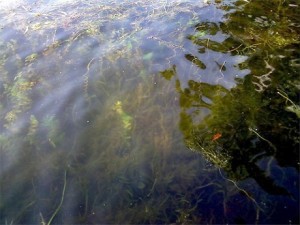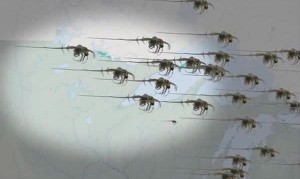Don’t let aquatic invasives hitch a ride

Boat washing station at Lake George boat launch. Photo: NYS DEC, Creative Commons, some rights reserved
These days, walking on water is not the big deal it once was. Back a long time ago, it required a miracle, but now all you need is a bad infestation of invasive aquatic plants. Anyone who has viewed a serious case of European watermilfoil, water chestnut, or hydrilla knows that a solid mat of vegetation stretching across a once-open waterway is a barrier to swimming, fishing, and boating. And that sometimes you can literally walk across it (but only in places where the water is real shallow).
New York claims to be the Empire State. I have no idea what that means, but we certainly are near the head of the pack in some ways. Nationally, NY State ranks third in population and second in apple production. But when it comes to invasive forest pests, it gets first prize. It is also in the top few for terrestrial and aquatic invasive species.
There are a number of reasons for our excellence in pestilence. New York has traded with Europe longer than most states, has many ports of entry, and an extensive canal system. Many invasive aquatic plants, though, are not a byproduct of our industry. Watermilfoil may have been introduced by the Goldfish Liberation Movement. Turns out that watermilfoil was commonly sold as an aquarium plant, and when Goldie was set free in some pond or stream, so were all her accoutrements. Other invasives came in by way of the St. Lawrence Seaway when ocean-going ships got here and relieved themselves of the bilge/ballast water they had been holding in since they left home.

Invasive Eurasian watermilfoil in Saratoga Lake. Photo: Janice Painter, Creative Commons, some rights reserved
Regardless of how these aquatic exotics first arrived, they have been spread far and wide by us. Not you and me, of course, but all the other people. Although most aquatic invasive plants make seeds, they typically multiply through fragments. Usually, just a snippet of plant clinging to a boat propeller, trailer, or other equipment is all it takes to start a new infestation in the next water body visited. It was once thought that when the plants dry out, they die, so one didn’t need to clean the boat if it was a few days before the next launch. Come to find out, some aquatic plants can survive being dried. Oops.
The weird thing is that the plants choking our lakes and rivers are not a problem in their native countries. This is because those places have scores of critters, insects primarily, that feed on the stuff and keep it in check. You’d think we would just go to China or Japan, scoop up a pile of bugs, and let them loose here. Of course it is not that easy. Each insect has to be vetted to ensure they do not also chomp on native plants, food crops, or small pets. To my knowledge, none has been shown to eat pets, but most of them get tossed out for bad behavior of some kind. A few have made it through, though, and others are still under study.
This year, New York State Parks is renewing its Watercraft Inspection Steward Program. This endeavor involves hiring 50 college students who spend all summer monitoring NYS boat launch sites for the purpose of encouraging boaters to clean their craft and gear. The students thereby earn minimum wage, a smattering of hostility, indifference, and sunburn, plus the occasional accolade. Most of the 50 sites are in the Adirondacks, so you could easily run into a launch steward when you put in your boat or canoe this year. Please be nice to them.
In addition, the NYS Department of Environmental Conservation has sponsored 20 boat wash and decontamination stations along major travel routes in the Adirondacks and elsewhere in the North Country. Pulling in is voluntary, but the boat wash is free, so you may as well take advantage of the service. Probably waxing costs extra. Watch for signs that say “Clean, Wash, Dry,” along with a picture of a boat. A thorough wash may seem excessive, but tiny invasives like spiny water flea can cling to boat hulls, or even a canoe paddle.
Most of us prefer to walk on dry land and use lakes and rivers for swimming and boating. Let’s help keep it that way. Don’t pick up hitchhikers.
Paul Hetzler is a horticulture and natural resources educator with Cornell Cooperative Extension of St. Lawrence County.
Tags: environment, invasive species, invasives, spiny water flea, watermilfoil







.png)

If you’re moving from one body of water to another, please be aware you and your trailer and boat and motor are the manner of conveyance for invasive species. More we know, smarter we are. David Duff